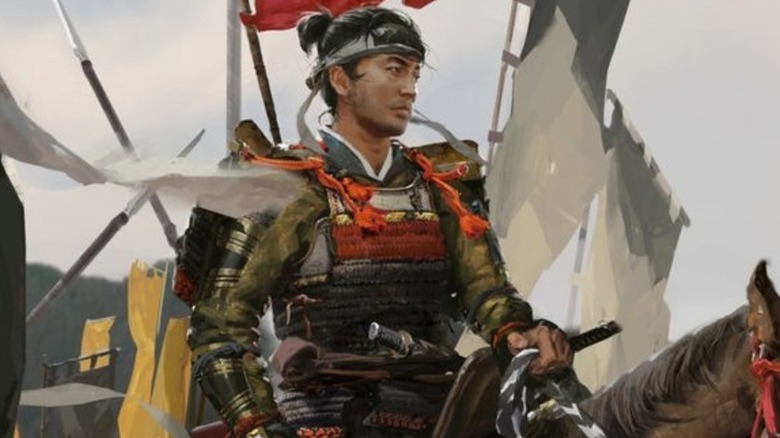We Finally Know What Inspired Ghost Of Tsushima
Ghost of Tsushima was released back in July and blew away critics and gamers alike. It shattered Sony sales records and has already received a new co-op mode, Ghost of Tsushima: Legends. The game's director has previously spoken about how Red Dead Redemption was a major influence on the scope and tone of Ghost of Tsushima. However, what fans may not realize about this game is that the story and characters are deeply rooted in a very real period of Japanese history.
Ian Jun Wei Chiew, the lead artist on Ghost of Tsushima, recently wrote a PlayStation blog post that described the process behind crafting one of 2020's biggest gaming blockbusters. Not only did Chiew share some of the original concept art for the game, but he also took readers on a journey, finally describing the inspiration behind Ghost of Tsushima's setting and designs.
According to Chiew, the biggest inspiration for Ghost of Tsushima came when Sucker Punch decided to set the tale during the Mongolian invasion of Japan in 1274. Once Sucker Punch had a time period and a concept for the main character locked in, everything seemed to flow naturally from there.
In the blog post, Chiew described how Sucker Punch then took a deep dive into Japanese history and culture. He explained, "We began by exposing ourselves to as much research and content as we could on the Kamakura Era, Japanese culture, old Samurai films and the Invasion of Tsushima, which led to the final designs of our characters, outfits, landscape, architecture, etc. A lot of the references we gathered were from museum exhibits and photos taken by teams that the studio sent out to Tsushima as well as the main island of Japan."
After the setting and time period was concrete, Sucker Punch proceeded to design the main character in ways that would make sense and show his character arc. As pointed out by Chiew, rogue warriors exactly like Jin didn't necessarily exist during the time period in which Ghost of Tsushima takes place. Because of this, the team had to make Jin's aesthetic evolve over time. To make that happen organically, Chiew allowed the fashions and materials of the time to inform Jin's transformation.
Make no mistake, there are plenty of different ways to customize Jin. Ghost of Tsushima is a lengthy game, taking about 50 hours for completionists to play through the full campaign and all of its side missions. Many of the game's quests will end with the lead character obtaining a new piece of armor or an upgrade of some kind. With that in mind, the team at Sucker Punch wanted to make sure that every new piece of gear fit the time period. Not only that, but it had to fit Jin's background as he made the transition from samurai to lone warrior.
Chiew explained, "Knowing that we wanted a character to have to let go of tradition and evolve into something out of necessity gave us this opportunity to tell a fictional story of a new kind of warrior ... Jin's arc of turning from the honorable samurai to the new dishonorable warrior was portrayed by including subtle intricate patterns as well as traditional armor plating pieces to make the Ghost outfit look more believable for that time."
Another result of Sucker Punch's extensive research is that there are a ton of references to Japanese mythology and history that may only be noticed by the adults playing Ghost of Tsushima. However, the game has also come under fire on a few occasions for occasional gaps in its authenticity. For instance, some people have criticized the game for featuring Japanese dialogue that isn't translated quite properly.
Ghost of Tsushima's setting has also caused a bit of an uproar among Chinese gamers. The period of time chosen by Sucker Punch is a hugely controversial subject in China. For years, Chinese nationalists have debated whether or not the Mongolians who once invaded and occupied China should be considered Chinese citizens. Some Chinese gamers have taken the Ghost's constant slaying of Mongolian enemies to be offensive and have called for the game to be banned, while many others are excited to see this period of history being portrayed in a AAA video game.
Despite the arguments over the game's authenticity and propriety, the fact stands that Sucker Punch apparently put a ton of effort into creating an immersive and exhaustively-researched experience. The blog post by Ian Jun Wei Chiew is a fascinating read for fans who are curious to see how Ghost of Tsushima came to be.

